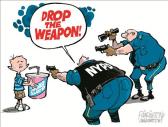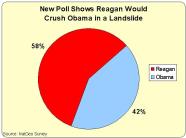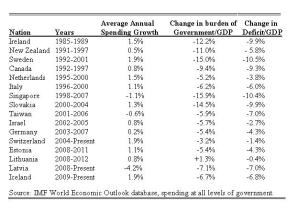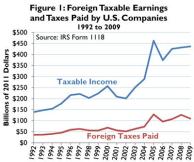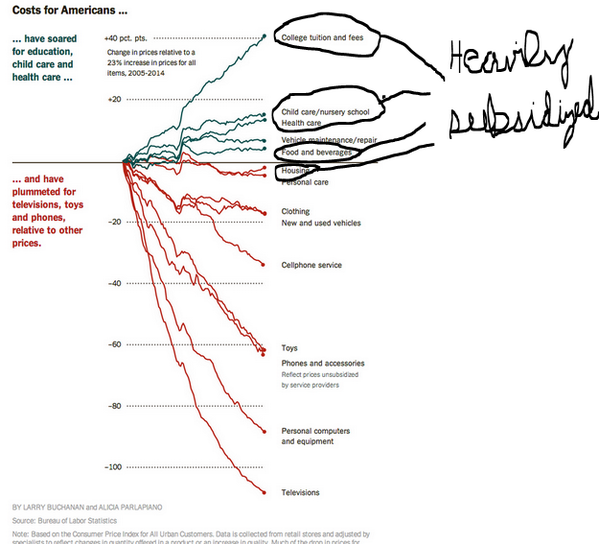Working the world of public policy, I’m used to surreal moments.
Such as the assertion that there are trillions of dollars of spending cuts in plans that actually increase spending. How do you have a debate with people who don’t understand math?
people who don’t understand math?
Or the oft-repeated myth that the Reagan tax cuts for the rich starved the government of revenue. How can you have a rational discussion with people who don’t believe IRS data?
And let’s not overlook my personal favorite, which is blaming so-called tax havens for the financial crisis, even though places such as the Cayman Islands had nothing to do with the Fed’s easy-money policy or with Fannie Mae and Freddie Mac subsidies.
These are all example of why my hair is turning gray.
But I’ll soon have white hair based on having to deal with the new claim from European bureaucrats that countries are guilty of providing subsidies if they have low taxes for companies.
I’m not joking. This is basically what’s behind the big tax fight between Apple, Ireland, and the European Commission.
Here’s what I said about this issue yesterday.
There are three things about this interview are worth highlighting.
- First, the European Commission is motivated by a desire for more tax revenue. Disappointing, but hardly surprising.
- Second, Ireland has benefited immensely from low-tax policies and that’s something that should be emulated rather than punished.
- Third, I hope Ireland will respond with a big corporate tax cut, just as they did when their low-tax policies were first attacked many years ago.
I also chatted with the folks from the BBC.
I’ll add a few comments on this interview as well.
- First, to the extent that the European Commission wants to interfere with fiscal policy in member states, it should urge spending caps for profligate welfare states.
- Second, since it’s been in bed with the Europeans on schemes to boost business taxation, the US government can’t throw stones since it lives in a glass house.
- Third, our friends on the left are terrified of a “race to the bottom” but their real motive seems to be a desire for more money to prop up big welfare states.
Here’s an interview from the morning, which was conducted by phone since I didn’t want to interrupt my much-needed beauty sleep by getting to the studio at the crack of dawn.
Once again, here are a few follow-up observations.
- First, I realize I’m being repetitive, but it’s truly bizarre that the European Commission thinks that low taxes are a subsidy. This is the left-wing ideology that the government has first claim on all income.
- Second, it’s a wonky point, but Europe’s high-tax nations can use transfer pricing rules if they think that Apple (or other companies) are trying to artificially shift income to low-tax countries like Ireland.
- Third, the U.S. obviously needs to reform its wretched corporate tax system, but that won’t solve this problem since it’s about an effort to impose more tax on Apple’s foreign-source income.
The Wall Street Journal opined wisely on this issue, starting with the European Commission’s galling decision to use anti-trust laws to justify the bizarre assertion that low taxes are akin to a business subsidy.
Even by the usual Brussels standards of economic malpractice, Tuesday’s €13 billion ($14.5 billion) tax assault on Apple is something to behold. …Apple paid all the taxes it owed under existing tax laws around the world, which is why it hasn’t been subject to enforcement proceedings by revenue authorities. …Brussels now wants to use antitrust law to tell Ireland and other low-tax countries how to apply their own tax laws. …Brussels is deploying its antitrust gnomes to claim that taxes that are “too low” are an illegal subsidy under EU state-aid rules.
This is amazing. A subsidy is when government officials use coercion to force taxpayers (or consumers) to pay more in order to line the pockets of a company or industry. The Export-Import Bank would be an example of this odious practice,  as would ethanol handouts.
as would ethanol handouts.
Choosing to tax at a lower rate is not in this category. It’s a reduction in government coercion.
That doesn’t necessarily mean we’re necessarily talking about good policy since there are plenty of preferential tax laws that should be wiped out as part of a shift to a simple and fair flat tax.
I’m simply pointing out that lower taxes are not “state aid.”
The WSJ also points out that it’s not uncommon for major companies to seek clarification rulings from tax authorities.
Brussels points to correspondence between Irish tax officials and Apple executives to claim that Apple enjoyed favors not available to other companies, which would be tantamount to a subsidy. But all Apple received from Dublin, in 1991 and 2007, were letters confirming how the tax authorities would treat various transactions under the Irish laws that applied to everyone. If anyone in Brussels knew more about tax law, they’d realize such “comfort letters” are common practice around the world.
Indeed, the IRS routinely approves “advance pricing agreements” with major American taxpayers.
This doesn’t mean, by the way, that governments (the U.S., Ireland, or others) treat all transactions appropriately. But it does mean that Ireland isn’t doing something strange or radical.
The editorial also makes the much-needed point that the Obama White House and Treasury Department are hardly in a position to grouse, particularly because of the demagoguery and rule-twisting that have been used to discourage corporate inversions.
As for the U.S., the Treasury Department pushed back against these tax cases, which it rightly views as a protectionist threat to the rule of law. But it’s hard to believe that Brussels would have pulled this stunt if Treasury enjoyed the global respect it once did. President Obama and Treasury Secretary Jack Lew have also contributed to the antibusiness political mood by assailing American companies for moving to low-tax countries.
Amen.
It’s also worth noting that the Obama Administration has been supportive of the OECD’s BEPS initiative, which also is designed to increase corporate tax burdens and clearly will disadvantage US companies.
A story from the Associated Press reveals the European Commission’s real motive.
The European Commission says…it should help protect countries from unfair tax competition. When one country’s tax policy hurts a neighbor’s revenues, that country should be able to protect its tax base.
Wow, think about what this implies.
We all recognize, as consumers, the benefits of having lots of restaurants competing for our business. Or several cell phone companies. Or lots of firms that make washing machines. Competition helps us by leading to lower prices, higher quality, and better service. And it also boosts the overall economy because of the pressure to utilize resources more efficiently and productively.
So why, then, should the European Commission be working to protect governments from competition? Why is it bad for a country with low tax rates to attract jobs and investment from nations with high tax rates?
 The answer, needless to say, is that tax competition is a good thing. Ever since the Reagan and Thatcher tax cuts got the process started, there have been major global reductions in tax rates, both for households and businesses, as governments have competed with each other (sadly, the US has fallen way behind in the contest for good business taxation).
The answer, needless to say, is that tax competition is a good thing. Ever since the Reagan and Thatcher tax cuts got the process started, there have been major global reductions in tax rates, both for households and businesses, as governments have competed with each other (sadly, the US has fallen way behind in the contest for good business taxation).
Politicians understandably don’t like this liberalizing process, but the tax competition-induced drop in tax rates is one of the reason why the stagflation of the 1960s and 1970s was replaced by comparatively strong growth in the 1980s and 1990s.
Let’s close by looking at one final story.
Bloomberg has a report on the Apple-Ireland-EC controversy. Here are some relevant passages.
Irish Finance Minister Michael Noonan on Tuesday vowed to fight a European Commission ruling… The country’s corporate tax regime is a cornerstone of its economic policy, attracting Google Inc. and Facebook Inc. to Dublin. …While the Apple ruling doesn’t directly threaten the 12.5 percent rate, the government has promised to stand by executives it says are helping the economy. “To do anything else, it would be like eating the seed potatoes,” Noonan told broadcaster RTE on Tuesday, adding a failure to fight the case would hurt future generations.
Kudos to Noonan for understanding that a short-term grab for more revenue will be bad news if the tradeoff is a more onerous tax system that reduces future growth.
I wish Hillary Clinton was capable of learning the same lesson.
Also, it’s worth noting that Apple is just the tip of the iceberg. If the EC succeeds, many other American companies will be under the gun.
The iPhone-maker is one of more than 700 U.S. companies that have units there, employing a combined 140,000 people, according to the American Chamber of Commerce in Ireland.
And when politicians – either here or overseas – raise taxes on companies, never forget that they’re actually raising taxes on worker, consumers, and shareholders.
P.S. Just in case you think the Obama Administration is sincere about defending Apple and other American companies, don’t forget that these are the folks who included a global corporate minimum tax scheme in the President’s most recent budget.
